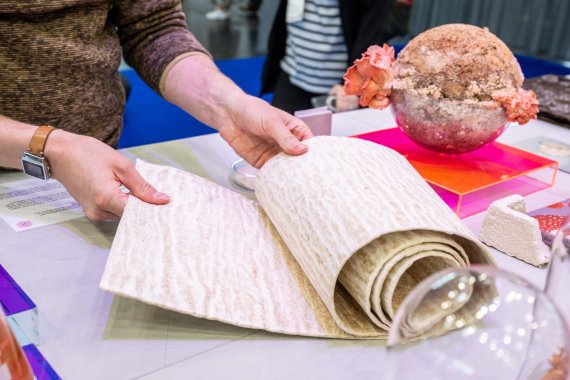Visitors to OutDoor were able to discover the latest material developments in the Material Lab. The materials developed by Studio Nima founder Leonhard Nima showcased the entire range of innovative, bio-based materials from material inventors from all over the world.
Leonhard Nima is considered a visionary sustainability pioneer who, as the founder of Studio Nima, is developing environmentally friendly materials with the aim of revolutionizing the textile industry.

Leonhard Nima presented more than 20 recyclable materials, including rubber alternatives made from walnut shells or olive pits (Kuori Materials), leather alternatives made from hemp (Revoltech) or yarn made with mud (Spinnova).
Nima's Material Lab turns all the showcase materials into an infotainment experience by vividly illustrating the development steps of hemp leather and co.
"In our Material Lab, we highlight the entire life cycle of these new materials. We show how the raw components are developed in various stages and finally refined into the final product," Leonhard Nima explains his concept in an interview with ISPO.com. "In this way, we want to ensure that all these materials are presented in a tangible and inspiring way."
At the panel talk "Inspired by nature: circular material innovations for a sustainable transformation", also at OutDoor, Leonhard Nima gave further insights and outlooks on the latest developments in innovative materials that have what it takes to become a transformation booster.

Together with Materialscout founder Efrat Friedland and Revoltech co-founder Lucas Fuhrmann, Nima provides insights into the progress that can be made with the materials of hope. For example, a leather substitute product from Revoltech, which is made from hemp, requires only 0.3 percent of the CO2 emissions generated by conventional leather production.
In recent years, the outdoor industry has increasingly focused on alternative fabrics and materials in order to reduce the ecological footprint of its products. Manufacturers are experimenting with all kinds of recycled, biodegradable and renewable raw materials to replace polyester and nylon.

But what is the current market situation and future prospects really like? A study by Grand View Research has determined that the market for sustainable textiles will grow by around 9.5 percent annually until 2027.
"Because consumers are placing more and more value on environmentally friendly and ethically responsible products, this is putting pressure on the industry to develop alternatives to conventional materials," explains Susanne Müller, Professor of Textile and Clothing Technology at Niederrhein University of Applied Sciences.
Alternative materials currently only make up a relatively small part of the market - 10 to 15 percent. Purely biodegradable materials are therefore still in their infancy. At the same time, however, the prospects are promising, as stricter regulations and growing consumer awareness are driving development forward.
Even outdoor top dogs such as Patagonia and The North Face are increasingly focusing on sustainable innovations. Patagonia, for example, has committed to sourcing 100% of its materials from recycled, renewable or responsibly sourced sources by next year.
Dr. Susanne Müller's forecast is: "Technologies for the development and production of alternative materials are developing rapidly, and with increasing pressure from consumers and legislators, the proportion of sustainable materials in the outdoor industry will certainly grow.
 SustainabilityReady for the Green Deal? An Update for the Sports Industry
SustainabilityReady for the Green Deal? An Update for the Sports Industry
- Awards
- Mountain sports
- Bike
- Fitness
- Health
- ISPO Munich
- Running
- Brands
- Sustainability
- Olympia
- OutDoor
- Promotion
- Sports Business
- Textrends
- Triathlon
- Water sports
- Winter sports
- eSports
- SportsTech
- OutDoor by ISPO
- Heroes
- Transformation
- Sport Fashion
- Urban Culture
- Challenges of a CEO
- Trade fairs
- Sports
- Find the Balance
- Product reviews
- Newsletter Exclusive Area
- Magazine



